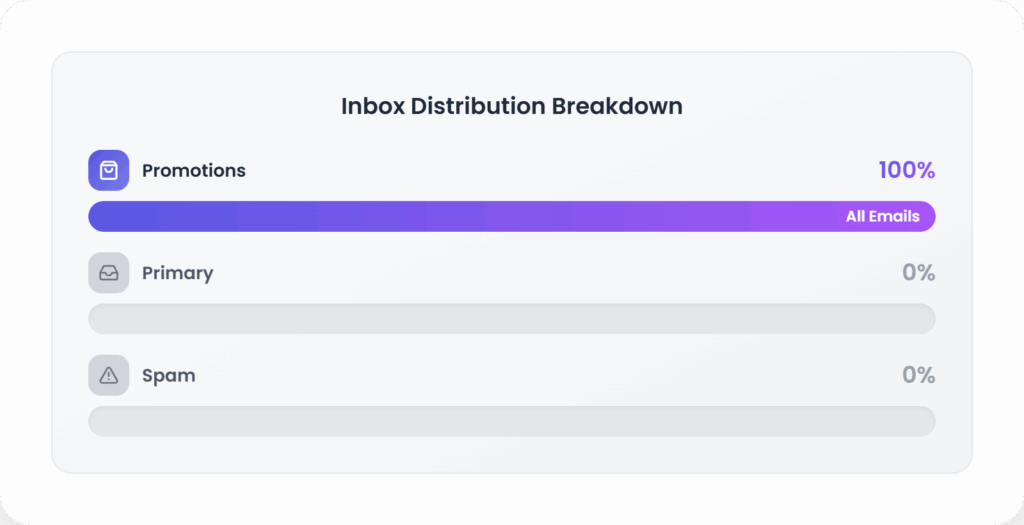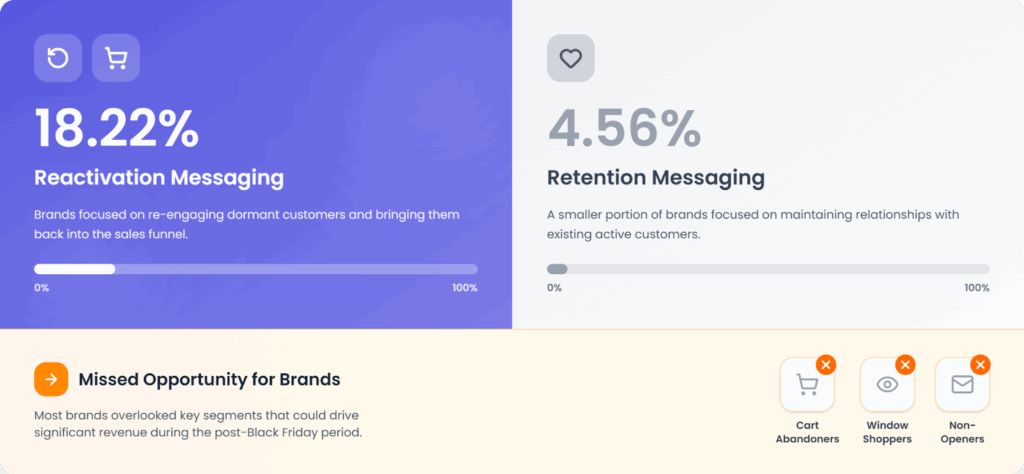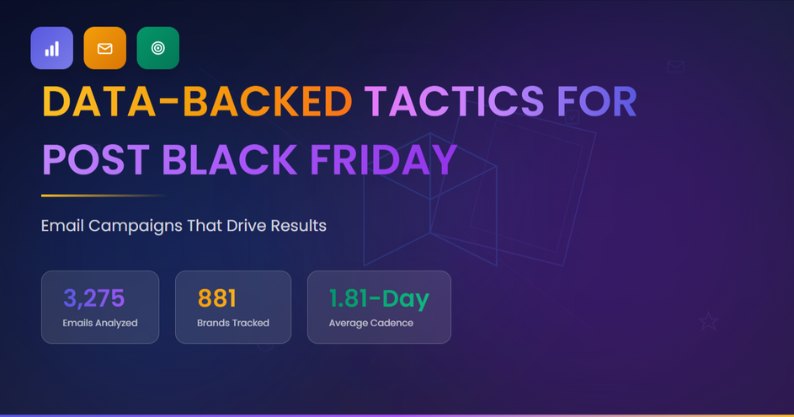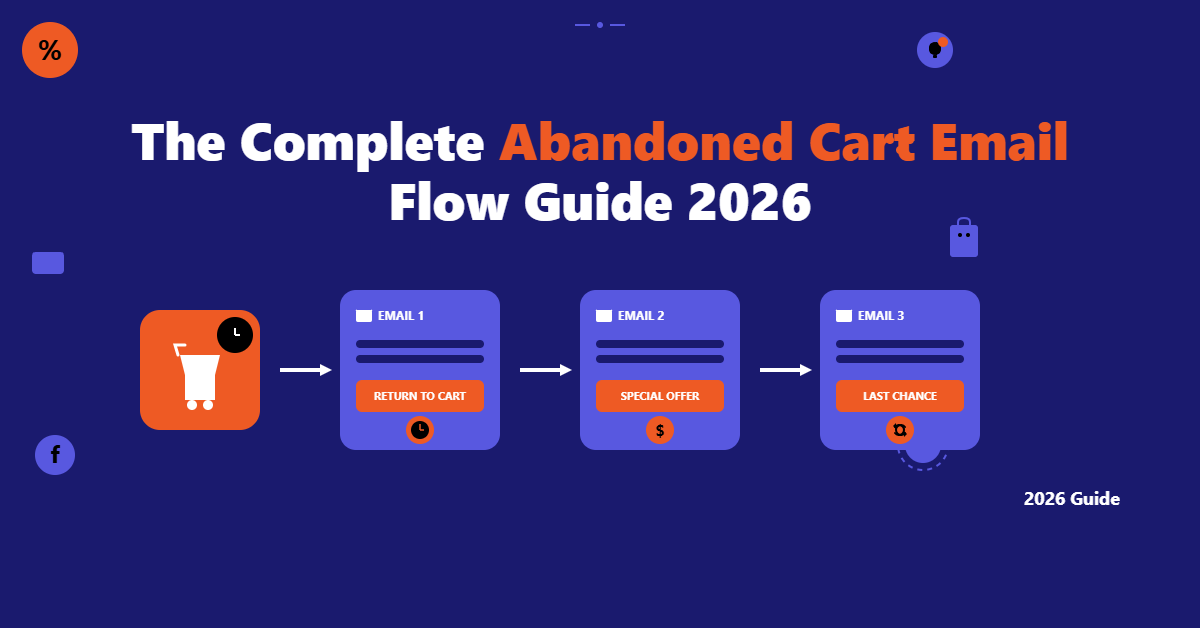Quick Summary
⏰ Timing matters: The average follow-up email is sent 1.81 days after Black Friday, typically pivoting to Cyber Monday or extended sales within 48 hours.
🔄 Reactivation drives results: 18.22% of post-BF emails use phrases like “Missed Out?” to re-engage non-buyers, but urgency must feel concrete.
📥 Emails land in Promotions: All post-Black Friday emails go to the Promotions tab, so clear, impactful design is essential to stand out.
🛍️ Offer extensions work: 24.13% of brands extended Black Friday deals through Cyber Monday, proving that thoughtful extensions can boost sales.
❤️ Retention is underused: Only 4.56% of brands focus on retaining recent buyers, missing a chance to nurture loyal customers.
Among dozens of last-chance deals in the promotions tab after Black Friday, one subject line stands out with a simple promise: extended savings for 48 hours.
That brand knows the modern playbook. Based on an analysis of 3,275 BFCM emails from 881 brands in 2024, the smartest post Black Friday email campaigns aren’t lucky guesses.
They followed a measurable pattern that pivots hard into Cyber Monday and Cyber Week without exhausting the list.
What the 2024 numbers say about the post-Black Friday window
From a pool of 3,275 emails across 881 brands, 461 were sent after Black Friday.
The aggregate cadence paints a consistent picture: the average follow-up went out 1.81 days after Black Friday.
In practical terms, most brands are pivoting into Cyber Monday or “extended sale” messaging within roughly 48 hours.
That window isn’t arbitrary; it’s where intent remains high, carts linger in memory, and holiday lists are still open.
For eCommerce marketers, this means the follow-up strategy must be set before Black Friday begins. If you’re building post Black Friday email campaigns on the fly, you’ll likely miss the window or end up repeating Black Friday creative that doesn’t land with urgency.
The 48-hour pivot is the new normal
A 1.81-day send window suggests a repeatable rhythm.
If your first Black Friday wave peaks on Friday, you’ve got Saturday and Sunday to transition copy and creative.
By Monday, your extended or Cyber Monday offer should feel timely, not recycled. Brands that plan a clear storyline—Black Friday, Extended, Cyber Monday, Last Chance—make the Promotions tab feel like a guided journey rather than a noisy wall of sameness.
Reactivation language works, but not on autopilot
Reactivation language appeared in 18.22% of post-Black Friday emails, and the phrasing is remarkably consistent. Think “Missed Out?,” “Still Time,” “Extended Through Cyber Monday,” or “We’re Not Done Yet.”
That consistency is both an advantage and a warning. It signals that consumers recognize the pattern and expect a second shot, but it also risks blending into the inbox if your value exchange isn’t fresh.
Using reactivation phrases in post Black Friday email campaigns can nudge fence-sitters, but avoid vague urgency.
Pair urgency with something concrete, a clear end date, a reduced inventory call-out, or a small sweetener that wasn’t available on Friday. When the urgency is believable, your follow-up feels like service, not pressure.
Make urgency believable
If you extended your offer, say why and how long. If you didn’t extend, use reactivation to spotlight alternative value, like bundles, gift-with-purchase, or expedited shipping cutoffs.
The most effective reactivation emails lead with clarity in the hero, reinforce credibility with social proof or reviews, and simplify the path to checkout to one tap.
More Black Friday Email Marketing Resources for You
Your follow-ups won’t hit spam, but they will hit Promotions

The analysis shows a stark placement reality: 100% of post-Black Friday emails landed in Promotions, with 0% in Primary and 0% flagged as spam, assuming you got the basic email infrastructure right for email deliverability.
That’s both reassuring and challenging. You’re not fighting deliverability penalties for sending quickly after Black Friday, but you are contending with a Promotions tab saturated with similar themes.
For marketers, this changes the playbook. Stop hoping for Primary. Optimize for Promotions. That means visual hierarchy that communicates the offer in seconds, subjects that win the scroll, and preheaders that carry clear utility rather than repeating the subject line.
Design for the Promotions tab
Assume your subscriber is triaging. Use a tight headline in the hero and ensure your offer mechanics are obvious above the fold.
If you extended your Black Friday deal, specify what changed. If you pivoted to Cyber Monday exclusives, show at least one representative product and price anchor right away. The Promotions tab rewards clarity and penalizes mystery.
Extending Black Friday through Cyber Monday: who, when, how
Nearly a quarter of brands extended their Black Friday offers through Cyber Monday or later.
The data shows 24.13% of brands (209 in total) chose extension. Extensions are not inherently cheapening when they’re framed thoughtfully.
They work best as a customer-friendly bridge for those who couldn’t shop on Friday, with messaging that feels planned, not opportunistic.
If you extend, say so plainly. A clean “Extended through Monday” or “Cyber Week pricing continues” subject line is more credible than vague teaser language.
Tie the extension to a reason, even if it’s simply expanded inventory or high demand, and avoid shifting the goalposts too many times. Consumers can tell when “last chance” isn’t actually last.
Protect full-price perception while extending
Guardrails help. You can narrow the extension to specific categories, change thresholds, or bring in a loyalty layer rather than re-running the same discount.
For example, offer existing customers early access to Cyber Monday bundles or free expedited shipping while the general discount remains steady. That protects perceived value and rewards your base.
Reactivation vs. retention: where brands placed their bets

The study splits post-Black Friday tactics into reactivation and retention emphasis.
Reactivation language showed up in 18.22% of emails, while retention-focused messaging accounted for just 4.56%. The tilt toward reactivation makes sense when you consider the opportunity: cart abandoners, window-shoppers, and non-openers are abundant after BF.
Still, there’s a missed upside for brands that ignore the customers who already trusted them on Friday.
The best post Black Friday email campaigns run on two rails.
One rail reactivates non-buyers with timely incentives and clear messaging. The other rail nurtures recent buyers with order reassurance, relevant cross-sells, care guides, and loyalty recognition.
Together, the two-rail approach recaptures missed revenue and protects your LTV.
Post-purchase nurtures that pay off in December
A brief post-purchase sequence can set you up for December revenue. Start with a warm confirmation and expectation-setter.
Follow with helpful content or quick add-ons that genuinely improve the original purchase. Reinforce social proof and invite a review once the item ships or arrives.
Solutions like TargetBay Reviews make it easy to request and showcase photo and video reviews at scale, which boosts credibility in your Cyber Week emails without heavy creative lifts.
If you run a loyalty program, a simple reminder of earned points via TargetBay Rewards can nudge a December repeat purchase without discounting.
A practical blueprint for post Black Friday email campaigns
A well-structured blueprint keeps your brand on message while the market gets noisy.
Start with a timeline that respects the 1.81-day send window, then orchestrate segments with tailored copy and offers.
Timeline
If Black Friday is your first major blast, schedule your post-BF follow-up for Sunday or Monday morning.
That aligns with the average 1.81-day cadence and rides the natural rise in Cyber Monday intent. A second follow-up can close out Monday evening or Tuesday morning, especially if your extension runs into Cyber Week.
Keep each send purposeful with a new angle rather than a duplicate.
Segmentation
Divide your audience by behavior. Non-buyers and soft-engaged subscribers may need a clearer value proposition or a lower-friction path to checkout.
Cart abandoners respond to specificity, reminding them of items and inventory pressure. Recent buyers deserve retention-focused messaging that thanks, informs, and invites.
This structure keeps your reactivation and retention goals in balance, avoiding discount fatigue while sustaining goodwill.
Messaging and subject lines
For reactivation, lean into clarity and time relevance. Strong variants include “Extended through Monday,” “Still time to save,” or “You didn’t miss it.”
Pair those with a preheader that sets the exact end, callouts like “Ends 11:59 PM,” or a differentiator such as “Free expedited shipping today.” For retention, say thank you, confirm next steps, and suggest complementary items sensibly.
If you offer loyalty benefits or points multipliers, state them plainly to elevate perceived value without shifting your core discount.
Cadence and channel mix
Two or three emails within the extended window usually suffice.
If you have SMS consent, a single concise reminder on Monday can perform well in the late afternoon or early evening when carts are revisited. Tools like TargetBay Email & SMS help you coordinate timing to reduce overlap and prevent over-messaging.
The goal is to show up helpfully at peak consideration moments, not to crowd the inbox.
Measurement guardrails
Because your emails will land in the Promotions tab, opens are a weaker signal than usual.
Watch click-through rate, revenue per recipient, and unsubscribe rate for a real read on impact. A well-run series may show modest opens but strong revenue concentration around one or two sends.
That’s normal in high-volume weeks and signals your creative is doing the heavy lifting where it counts.
More Black Friday Email Marketing Resources for You
Creative and offer construction tuned to Promotions
Design for rapid comprehension. Your hero should tell the entire story in a glance: the offer, the timeframe, and the next step.
Use product imagery to anchor value and avoid generic hero art that could belong to any brand. If you extended, differentiate the visual slightly from Black Friday assets to make the update feel intentional.
Pricing clarity is crucial; show a compare-at price or savings callout to reduce mental math.
Social proof becomes an unfair advantage here. Real reviews increase trust in a sea of discounts.
If you’re not already collecting user-generated content, a quick integration with a platform like TargetBay Reviews can operationalize requests and showcase assets quickly.
Place a small trust block near your CTA to improve click confidence without crowding the layout.
What to avoid in the post-Black Friday sprint
The Promotions tab is littered with empty urgency. Avoid moving your deadline more than once.
Over-sending erodes list health quickly; respect fatigue signals from unsubscribes and suppressed engagement.
Don’t punish early buyers by offering a materially better deal two days later, if you need to sweeten, use loyalty perks or shipping benefits rather than deeper markdowns.
Above all, don’t ship a follow-up that looks indistinguishable from your Black Friday creative. The consumer needs a reason to care now.
Why these tactics compound through December
A disciplined approach to post Black Friday email campaigns doesn’t just lift Cyber Monday.
It also sets momentum for the rest of December. Reactivated window-shoppers become buyers, and well-served Black Friday customers come back for accessories, gifts, or refills.
Reviews collected in early December fuel your evergreen PDPs, and loyalty touchpoints reduce the need for heavier discounts as shipping cutoffs approach.
The data underscores speed, clarity, and trust. With 461 post-Black Friday emails captured, the average 1.81-day send window is your North Star.
With 24.13% of brands extending offers, the extension play is both common and competitive, so execution matters more than the concept.
With 100% landing in Promotions, creative and copy must win the triage. And with 18.22% leaning into reactivation versus 4.56% on retention, there’s room to differentiate by taking better care of your new customers.
Thoughtful, data-driven post black friday email campaigns are a quiet edge in a loud week.
When your email, SMS, reviews, and loyalty live under one roof, orchestration gets easier and results get more predictable. TargetBay brings Email & SMS, Reviews, and Rewards together so your team can plan the 48-hour pivot, showcase real customer proof, and reward buyers without discounting deeper.
In a Promotions tab full of noise, that kind of unity reads as confidence, and converts like it, too.





